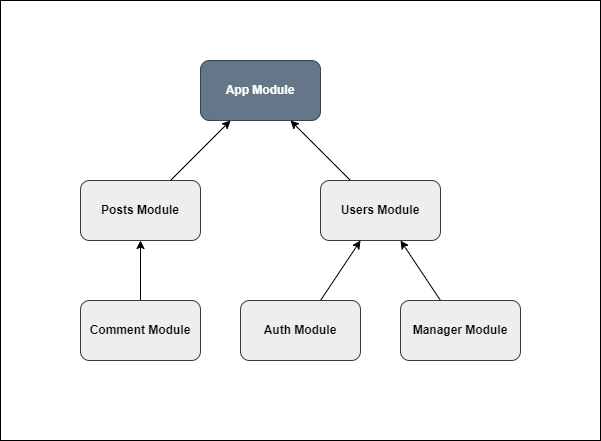Module
A Module in Tinh Tinh is a fundamental building block that encapsulates a cohesive set of controllers, providers (services), middleware, guards, and configuration. Modules enable you to organize your code into logical, reusable, and testable units, supporting both small and large-scale applications.

Modules can be composed, imported, and exported, allowing for hierarchical and feature-based app architecture—similar to dependency injection systems in other modern frameworks.
Module Features
- Encapsulation: Bundle related controllers, providers, middleware, and guards in a single unit.
- Dependency Injection: Register and inject services/providers with support for different lifecycles (
Global,Request,Transient). - Composable Imports/Exports: Import other modules and export services/providers for reusability.
- Hierarchical Structure: Model your app as a tree of modules, with clear boundaries and dependencies.
- Custom Initialization: Use
OnInithooks for module-level bootstrapping. - Scoping: Define the visibility and lifecycle of providers within and across modules.
- Middleware & Guards: Attach middleware and guards at module-level.
- Extensibility: Add custom consumers, global interceptors, and more.
Creating a Module
The most common way is using core.NewModule with core.NewModuleOptions:
import "github.com/tinh-tinh/tinhtinh/v2/core"
func NewAppModule() core.Module {
return core.NewModule(core.NewModuleOptions{
Controllers: []core.Controllers{UserController, ArticleController},
Providers: []core.Providers{UserService},
Middlewares: []core.Middleware{LoggerMiddleware},
Imports: []core.Modules{OtherModule},
Exports: []core.Providers{UserService}, // Export providers for other modules
Scope: core.Global, // or core.Request, core.Transient
})
}
Passing Parameters to a Module
When initializing a module, you can pass configuration via the NewModuleOptions struct. Each module receives its own options, which can include:
- Controllers: Array of controller constructors.
- Providers: Array of provider/service constructors.
- Imports: Other modules to import dependencies from.
- Exports: Which providers/services to export.
- Middlewares: Functions to run on all requests within the module.
- Guards: Access control functions.
- Scope: Singleton, per-request, or per-injection (
Global,Request,Transient). - Custom Options: You can extend the pattern to accept custom configs in your own code.
Example:
type MyConfig struct {
Debug bool
}
// Pass as needed when constructing providers or wiring up modules
core.NewModule(core.NewModuleOptions{
Providers: []core.Providers{
func(module core.Module) core.Provider {
return module.NewProvider(core.ProviderOptions{
Name: "config",
Value: &MyConfig{Debug: true},
})
},
},
})
Hierarchical Modules: Multi-Module Initialization
Modules can import other modules, forming a tree-like structure. This enables clear separation of features and easy reusability.
func SubModule(module core.Module) core.Module {
sub := module.New(core.NewModuleOptions{
Controllers: []core.Controllers{SubController},
Providers: []core.Providers{SubService},
Exports: []core.Providers{SubService},
})
return sub
}
func ParentModule(module core.Module) core.Module {
parent := module.New(core.NewModuleOptions{
Imports: []core.Modules{SubModule},
Controllers: []core.Controllers{ParentController},
Providers: []core.Providers{ParentService},
Exports: []core.Providers{ParentService},
})
return parent
}
func AppModule() core.Module {
return core.NewModule(core.NewModuleOptions{
Imports: []core.Modules{ParentModule},
Controllers: []core.Controllers{AppController},
})
}
- Importing: Use the
Importsoption to compose features. - Exporting: Use
Exportsto make providers/services available to parent modules. - Dependency Resolution: Providers and controllers can inject dependencies from their own module or any imported/exported modules.
Example: Minimal Module Setup
package app
import "github.com/tinh-tinh/tinhtinh/v2/core"
func NewModule() core.Module {
appModule := core.NewModule(core.NewModuleOptions{
Controllers: []core.Controllers{NewController},
Providers: []core.Providers{NewService},
})
return appModule
}
Module Hooks
- OnInit: Register initialization hooks for setup logic inside the module.
Middleware and Guards
- Use: Attach middleware to all controllers/routes inside the module.
- Guard: Attach guards (authorization logic) to all controllers/routes inside the module.
Summary
- Modules are the foundation of Tinh Tinh's architecture.
- They enable encapsulation, hierarchy, dependency injection, and easy code organization.
- Compose modules hierarchically to scale your application while maintaining separation of concerns and reusability.
For advanced patterns, see the source code and test files in /core.